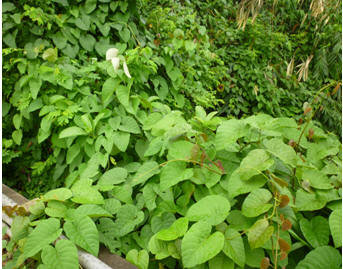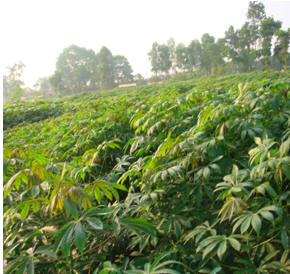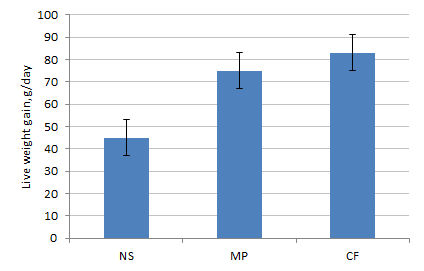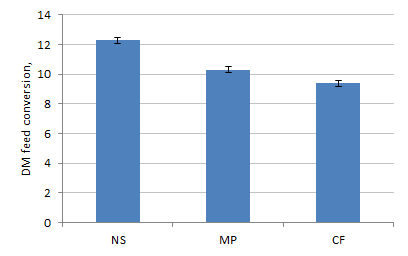 |
Photo 1: M. peltata growing in GRRC |
|
Livestock-Based Farming Systems, Renewable Resources and the Environment |
Citation |
Twelve Indian crossbred goats with an initial weight of 14.5 kg and at 4-5 months of age were used to study Merremia peltata Merr as forage source. The goats were allocated to three treatments in a completely randomised design. The experimental diets contained only Guinea grass ad libitum (NS), guinea grass ad libitum supplemented with 1% of the body weight (LW) with cassava foliage (CF) or Merremia peltata (MP). All diets contained a rumen supplement (10% urea, 20% molasses, 2% sulphur, 5% calcium phosphate, 5% salt and 58% rice bran) at 2 g per 1 kg live weight and cassava chips at 1% of the LW. The experiment lasted for 90 days.
Growth rates of the goats were improved by 64 and 87%, and DM feed conversion by 16 and 24%, when the basal diet of Guinea grass, rumen supplement and cassava chips was supplemented with foliage of M peltata and cassava, respectively.
Merremia peltata is a species of flowering vine in the morning glory family, Convolvulaceae, that is native to Pemba Island, the Mascarene Islands, Madagascar, the Seychelles, Indonesia, Malaysia, the Philippines, northern Queensland and French Polynesiaa http://en.wikipedia.org/wiki/Merremia_peltata
M. peltata grows wild and in abundance in Vietnam, spreading from the delta to the mountain in the North of Vietnam (Photo 1). The plant appears to be highly palatable according to local farmers who feed leaves and vines to small ruminants, with no health problems. However, there appear to be no reports on its use as ruminant forage source.
 |
Photo 1: M. peltata growing in GRRC |
The objective of this research was to evaluate Merremia peltata as a feed resource for growing goats in rural areas especially moutainous areas of Vietnam.
The experiment was conducted at the Goat and Rabbit Research Center, Son Tay, Hanoi, Vietnam, longitude E 105o25 and latitude N 21o06. The altitude is about 220 m above sea level. The climate in this area is tropical monsoon with a wet season between April and November and a dry season from December to March. Average annual rainfall is 1850 mm, with a mean temperature range of 24oc to 32oC.
Twelve growing goats (4-5 months of age) were fed a basal diet of Guinea grass (ad libitum), cassava chips at 1% of LW and a rumen supplement at 2 g/kg LW. The three treatments according to a completely random design were:
NS: No supplement (basal diet only
CD: FResh cassava foliage at 1.5% of LW (DM basis)
MP: Fresh foliage of M. peltata at 1.5% of LW (DM basis)
The goats were crossbred males with an initial weight of 14.5 kg and 4-5 months of age. They were housed in complete confinement in wooden pens of 1.2 x1.4 m area on a slatted floor. They were treated for parasites with Ivermectin solution (1 ml per 4 kg BW) before starting the experiment, which lasted for 90 days, following a 10 day adaptation period.
The M. peltata was obtained from natural stands in the GRRC. It was cut into 10-12 cm long pieces before being offered to the goats. The guinea grass was cultivated in GRRC. The experimental feeds were supplied 4 times daily at7 and 10 am; 2 and 5 pm. Cassava was cultivated in the GRRC and the foliage harvested after 2 months of regrowth (Photo 2).
 |
|
Photo 2. Cassava foliage growing in GRRC |
Feeds offered and refused were recorded daily and samples analyzed for DM, CP, NDF, ADF and ash according to the standard methods of AOAC (1990). The goats were weighed at 15 day intervals.
The data were analyzed statically using the GLM procedure of Minitab Software, version 13.1 (Minitab2000). Treatment means which showed significant difference at the probability level of P<0.05 were compared using Tukey’s pair wise comparison procedures. The statistical model was:
Yi = m +Ti+ ei
Where Yi was the dependent variable, m was the overall mean, ei was the random error, independent and normally distributed.
Cassava foliage had the highest content of crude protein and Guinea grass the lowest with an intermediate value for the M peltata (Table 1).
|
Table 1: Chemical composition of experimental feeds |
|||||
|
Feed samples |
DM |
% in DM |
|||
|
CP |
Ash |
NDF |
ADF |
||
|
Merremia peltata |
18.1 |
14.0 |
7.97 |
59.71 |
27.6 |
|
Guinea grass |
20.5 |
9.4 |
10.6 |
66.3 |
45.1 |
|
Cassava foliage |
24.8 |
17.8 |
8.8 |
59.5 |
31.1 |
|
Cassava chips |
90.7 |
2.7 |
1.6 |
2.3 |
5.1 |
|
Supplement |
50 |
16 |
- |
- |
- |
The intake of Guinea grass was reduced and of the total diet increased when the basal diet was supplemented with foliage of cassava foliage or M peralta (Table 2).
|
Table 2: Mean values for the intake of the goats fed a basal diet of Guinea grass, rumen supplement and cassava chips (NS) or supplemented with M peltata (MP) or cassava foliage (CF) |
||||
|
|
NS |
CF |
MP |
SEM |
| DM intake, g/day | ||||
|
Guinea grass |
397c |
321b |
269a |
7.3 |
|
M peltata |
- |
- |
314 |
|
|
Cassava foliage |
- |
281 |
- |
|
|
Cassava chips |
140a |
155b |
164c |
2.0 |
|
Total |
555a |
777b |
769b |
7.3 |
|
DMI, g/kg LW |
33a |
42b |
43b |
0.6 |
|
Crude protein, g/kg DM |
106 |
134 |
124 |
|
|
a,b, c Means within rows without common superscripts are different at P<0.05 |
||||
Growth rates of the goats were improved by 64 and 87%, and DM feed conversion by 16 and 24%, when the basal diet of Guinea grass, rumen supplement and cassava chips was supplemented with foliage of M peltata and cassava, respectively (Table 3; Figures 1 and 2).
|
Table 3: Mean values for changes in live weight and DM feed conversion of goats fed a basal diet of Guinea grass, rumen supplement and cassava chips (NS) or supplemented with M peltata (MP) or cassava foliage (CF) |
||||
|
|
NS |
CF |
MP |
SEM |
|
Initial weight, kg |
15.0 |
14.8 |
14.8 |
0.9 |
|
Final weight, kg |
19.0a |
22.2b |
21.6b |
0.8 |
|
LWG, g/day |
45a |
83b |
75b |
8 |
|
FCR, kg DM/kg LWG |
12.3c |
9.4a |
10.3b |
0.2 |
|
abcMeans within rows without common superscripts are different at P<0.05 |
||||
 |
 |
| Figure 1: Growth rate of the goats fed a basal diet of Guinea grass, rumen supplement and cassava chips (NS) supplemented with M peltata (MP) or cassava (CF) foliage | Figure 2: DM feed conversion of the goats fed a basal diet of Guinea grass, rumen supplement and cassava chips (NS) supplemented with M pertalta (MP) or cassava (CF) foliage |
The beneficial effects from supplements of cassava foliage on growth rates and feed conversion in ruminants fed diets in which crude protein levels were not limiting has been well doumented (Ffoulkes and Preston 1978; Ho Quang Do et al 2002; Mom Seng et al 20; Keo Sath et al 2019). The results from the present research lend further support to these findings. The observed comparable benefits from a supplement of M peltata foliage merit wider investigation and especially the potential of this plant to form the sole diet of goats as well as of large ruminants.
Growth rates of goats were improved by 64 and 87%, and DM feed conversion by 16 and 24%, when the basal diet of Guinea grass, rumen supplement and cassava chips was supplemented with foliage of M peltata and cassava, respectively.
M peltata appears to have considerable potential to be developed as the sole feed for goats. Agronomic studies are needed to measure response to repeated harvests and effects on soil fertility.
We would like to acknowledge the support of the Swedish International Development Agency (Sida) in funding this experiment as part of the regional MEKARN project.
AOAC 1990 Association of Analytical Chemists, 15th ed. Official Methods of Analysis, Washington, DC.
Ffoulkes D and Preston T R 1978 C
assava or sweet potato forage as combined sources of protein and roughage in molasses based diets: Effect of supplementation with soybean meal. Tropical Animal Production http://www.utafoundation.org/UTAINFO1/TAP/TAP33/3_3_1.pdfHo Quang Do, Vo Van Son, Bui Phan Thu Hang, Vuong Chan Tri and Preston T R 2002 Effect of supplementation of ammoniated rice straw with cassava leaves or grass on intake, digestibility and N retention by goats. Livestock Research for Rural Development. http://www.lrrd.org/lrrd14/3/do143b.htmMinitab 2008 Minitab user's guide. Data analysis and quality tools. Release 18.1 for windows. Minitab Inc., Pennsylvania, USA.
Minitab 2008 Minitab user's guide. Data analysis and quality tools. Release 18.1 for windows. Minitab Inc., Pennsylvania, USA.
Sath K, Borin K and Preston T R 2008: Effect of levels of sun-dried cassava foliage on growth performance of cattle fed rice straw. Livestock Research for Rural Development. Volume 20, supplement. http://www.lrrd.org/lrrd20/supplement/sath2.htm
Seng Mom, Preston T R, Leng R A and ter Meulen U 2001 Effect of a single drench of cooking oil on the rumen ecosystem and performance of young local "yellow" cattle fed rice straw and cassava foliage Livestock Research for Rural Development. http://www.lrrd.org/lrrd13/4/seng134.htm